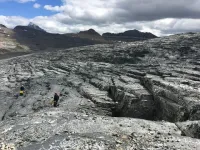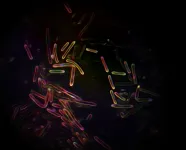(Press-News.org) Scientists have used fibre-optic sensing to obtain the most detailed measurements of ice properties ever taken on the Greenland Ice Sheet. Their findings will be used to make more accurate models of the future movement of the world's second-largest ice sheet, as the effects of climate change continue to accelerate.
The research team, led by the University of Cambridge, used a new technique in which laser pulses are transmitted in a fibre-optic cable to obtain highly detailed temperature measurements from the surface of the ice sheet all the way to the base, more than 1000 metres below.
In contrast to previous studies, which measured temperature from separate sensors located tens or even hundreds of metres apart, the new approach allows temperature to be measured along the entire length of a fibre-optic cable installed in a deep borehole. The result is a highly detailed profile of temperature, which controls how fast ice deforms and ultimately how fast the ice sheet flows.
The temperature of ice sheets was thought to vary as a smooth gradient, with the warmest sections on the surface where the sun hits, and at the base where it's warmed by geothermal energy and friction as the ice sheet grinds across the subglacial landscape toward the ocean.
The new study found instead that the temperature distribution is far more heterogenous, with areas of highly localised deformation warming the ice further. This deformation is concentrated at the boundaries between ice of different ages and types. Although the exact cause of this deformation remains unknown, it may be due to dust in the ice from past volcanic eruptions or large fractures which penetrate several hundred metres below the surface of the ice. The results are reported in the journal Science Advances.
Mass loss from the Greenland Ice Sheet has increased sixfold since the 1980s and is now the single largest contributor to global sea-level rise. Around half of this mass loss is from surface meltwater runoff, while the other half is driven by discharge of ice directly into the ocean by fast flowing glaciers that reach the sea.
In order to determine how the ice is moving and the thermodynamic processes at work within a glacier, accurate ice temperature measurements are essential. Conditions on the surface can be detected by satellites or field observations in a relatively straightforward way. However, determining what is happening at the base of the kilometre thick ice sheet is far more challenging to observe, and a lack of observations is a major cause of uncertainty in projections of global sea-level rise.
The RESPONDER project, funded by the European Research Council, is addressing this problem using hot-water drilling technology to bore through Sermeq Kujalleq (Store Glacier) and directly study the environment at the base of one of Greenland's largest glaciers.
"We normally take measurements within the ice sheet by attaching sensors to a cable that we lower into a drilled borehole, but the observations we've made so far weren't giving us a complete picture of what's happening," said co-author Dr Poul Christoffersen from the Scott Polar Research Institute who leads the RESPONDER project. "The more precise data we are able to gather, the clearer we can make that picture, which in turn will help us make more accurate predictions for the future of the ice sheet."
"With typical sensing methods, we can only attach about a dozen sensors onto the cable, so the measurements are very spaced out," said first author Robert Law, a PhD candidate at the Scott Polar Research Institute. "But by using a fibre-optic cable instead, essentially the whole cable becomes a sensor, so we can get precise measurements from the surface all the way to the base."
To install the cable, the scientists had to first drill through the glacier, a process led by Professor Bryn Hubbard and Dr Samuel Doyle from Aberystwyth University. After lowering the cable into the borehole, the team transmitted laser pulses in the cable, and then recorded the distortions in the scattering of light in the cable, which vary depending on the temperature of the surrounding ice. Engineers at Delft University of Technology in the Netherlands and geophysicists at the University of Leeds assisted with data collection and analysis.
"This technology is a big advance in our ability to record spatial variations in ice temperature over long distances and at really high resolution. With some further adaptations, the technique can also record other properties, such as deformation, at similarly high resolution," said Hubbard.
"Overall, our readings paint a picture that's far more varied than what current theory and models predict," said Christoffersen. "We found temperature to be strongly influenced by the deformation of ice in bands and at the boundaries between different types of ice. And this shows there are limitations in many models, including our own."
The researchers found three layers of ice in the glacier. The thickest layer consists of cold and stiff ice which formed over the last 10,000 years. Below, they found older ice from the last ice age, which is softer and more deformable due to dust trapped in the ice. What surprised the researchers the most, however, was a layer of warm ice more than 70 metres thick at the bottom of the glacier. "We know this type of warm ice from far warmer Alpine environments, but here the glacier is producing the heat by deforming itself," said Law.
"With these observations, we are starting to better understand why the Greenland Ice Sheet is losing mass so quickly and why discharge of ice is such a prominent mechanism of ice loss," said Christoffersen.
One of the major limitations in our understanding of climate change is tied to the behaviour of glaciers and ice sheets. The new data will allow the researchers to improve their models of how the Greenland Ice Sheet is currently moving, how it may move in the future, and what that this will mean for global sea-level rise.
The research was funded in part by the European Union.
INFORMATION:
A microscope used by Antoni van Leeuwenhoek to conduct pioneering research contains a surprisingly ordinary lens, as new research by Rijksmuseum Boerhaave Leiden and TU Delft shows. It is a remarkable finding, because Van Leeuwenhoek (1632-1723) led other scientists to believe that his instruments were exceptional. Consequently, there has been speculation about his method for making lenses for more than three centuries. The results of this study were published in Science Advances on May 14.
Previous research carried out in 2018 already indicated that some of Van Leeuwenhoek's microscopes contained common ground lenses. Researchers have now examined ...
In research made possible when COVID-19 sidelined other research projects, scientists at Johns Hopkins Medicine meticulously counted brain cells in fruit flies and three species of mosquitos, revealing a number that would surprise many people outside the science world.
The insects' tiny brains, on average, have about 200,000 neurons and other cells, they say. By comparison, a human brain has 86 billion neurons, and a rodent brain contains about 12 billion. The figure probably represents a "floor" for the number needed to perform the bugs' complex behaviors.
"Even though these brains are simple [in contrast to mammalian brains], they can do a lot of processing, even more than a supercomputer," says Christopher Potter, Ph.D., associate professor of neuroscience ...
Being treated fairly is important - but fairness alone isn't enough to make people feel valued in a workplace or other groups, new research suggests.
Researchers found that "distinctive treatment" - where a person's talents and qualities are recognised - provides this sense of value while also reinforcing their sense of inclusion. It also promotes mental health.
The findings suggest there is no conflict between "fitting in" and "standing out" in groups - in fact, they complement each other.
But while the importance of fairness is widely accepted, the researchers say distinctive treatment is ...
AMES, Iowa - The field photos show the hard, rough country that some glaciers slide over: rocky domes and bumps in granite, rocky steps and depressions in limestone. The glacier beds dwarf the researchers and their instruments. (As do the high mountains pictured on the various horizons.)
During their trips to glacier beds recently exposed by retreating glaciers in the Swiss Alps (Rhone, Schwarzburg and Tsanfleuron glaciers) and the Canadian Rockies (Castleguard Glacier), four glaciologists used laser and drone technology to precisely measure the rocky beds and record their very different contours.
The researchers turned the measurements into high-resolution digital models of those glacier beds. Then they went to work with manageable but representative subunits of the ...
Better designed vaccines for insect-spread viruses like dengue and Zika are likely after researchers discovered models of immature flavivirus particles were originally misinterpreted.
Researchers from The University of Queensland and Monash University have now determined the first complete 3D molecular structure of the immature flavivirus, revealing an unexpected organisation.
UQ researcher Associate Professor Daniel Watterson said the team was studying the insect-specific Binjari virus when they made the discovery.
"We were using Australia's safe-to-handle Binjari virus, which we combine with more dangerous viral genes to make safer and more effective vaccines," Dr Watterson ...
ITHACA, NY, May 13, 2021 -- Cyanobacteria are one of the unsung heroes of life on Earth. They first evolved to perform photosynthesis about 2.4 billion years ago, pumping tons of oxygen into the atmosphere - a period known as the Great Oxygenation Event - which enabled the evolution of multicellular life forms.
Led by BTI faculty member END ...
The United States has witnessed a steep rise in reports, arrests, and media coverage of teachers' sexual misconduct with students. A new study investigated the impact of perpetrators' gender, sexuality, and age on perceptions of teacher sexual misconduct. The study found that
responses to teachers' misconduct varied according to certain characteristics, which can influence whether victims report the misconduct.
The study, by researchers at Prairie View A&M University and the University of Nevada, Reno, appears in Feminist Criminology.
"Because sexual abuse of a child or adolescent in any context has substantial psychological, emotional, and physical consequences for the victim, teachers' sexual misconduct is a serious public health ...
Developing self-healing materials is nothing new for Nancy Sottos, lead of the Autonomous Materials Systems Group at the END ...
Three billion years ago, light first zipped through chlorophyll within tiny reaction centers, the first step plants and photosynthetic bacteria take to convert light into food.
Heliobacteria, a type of bacteria that uses photosynthesis to generate energy, has reaction centers thought to be similar to those of the common ancestors for all photosynthetic organisms. Now, a University of Michigan team has determined the first steps in converting light into energy for this bacterium.
"Our study highlights the different ways in which nature has made use of the basic reaction ...
May 14, 2021 - Two thirds of all pediatric spinal fractures, especially in the adolescent population, occur in motor vehicle accidents (MVAs) where seatbelts are not utilized, reports a study in Spine. The journal is published in the Lippincott portfolio by Wolters Kluwer.
"Over 60 percent of pediatric spinal fractures occur in children ages 15 to 17, coinciding with the beginning of legal driving," according to the new research by Dr. Vishal Sarwahi, MD, of Cohen Children's Medical Center, New Hyde Park, NY, and colleagues. They emphasize the need for measures to increase seatbelt usage, particularly by younger drivers, and outline the potential trauma that can be avoided through proper seatbelt use.
Seatbelts save lives... and ...





